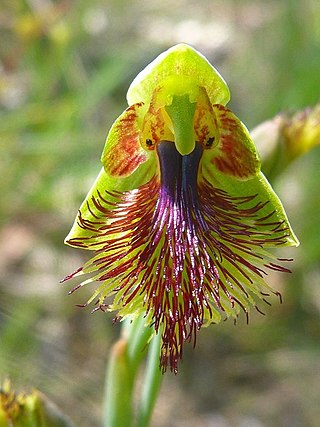
Epipogium, commonly known as ghost orchids, is a genus of four species of terrestrial leafless orchids in the family Orchidaceae. Orchids in this genus have a fleshy, underground rhizome and a fleshy, hollow flowering stem with small, pale coloured, drooping, short-lived flowers with narrow sepals and petals. They are native to a region extending from tropical Africa to Europe, temperate and tropical Asia, Australia and some Pacific Islands.

Dipodium, commonly known as hyacinth orchids, is a genus of about forty species of orchids native to tropical, subtropical and temperate regions of south-east Asia, New Guinea, the Pacific Islands and Australia. It includes both terrestrial and climbing species, some with leaves and some leafless, but all with large, often colourful flowers on tall flowering stems. It is the only genus of its alliance, Dipodium.

Dipodium punctatum, commonly known as the blotched hyacinth-orchid, is a leafless orchid that is a native to eastern and south-eastern continental Australia. In summer it produces a tall flowering stem with up to sixty pale to bright pink flowers with heavy red blotches. A widespread and common species it is often confused with D. roseum and some authorities regard it as a synonym of D. squamatum.

Dipodium elegantulum, commonly known as the elegant hyacinth orchid, is a leafless orchid that is endemic to Queensland. In spring and summer it has up to sixty pale to dark pink flowers with a few darker spots and streaks near the tips, on a tall flowering stem.

Dipodium roseum, commonly known as rosy hyacinth-orchid or pink hyacinth-orchid, is a leafless saprophytic orchid found in east and south-eastern Australia. In summer it produces a tall flowering stem with up to fifty pale pink flowers with small, dark red spots. A widespread and common species it is often confused with D. punctatum but has darker, less heavily spotted flowers.

Dipodium hamiltonianum, commonly known as yellow hyacinth-orchid, is a leafless mycoheterotroph orchid that is endemic to eastern Australia. It has up to twenty five greenish flowers with dark red spots on a tall flowering stem.

Dipodium variegatum, commonly known as the slender hyacinth-orchid, or blotched hyacinth-orchid, is a leafless mycoheterotrophic orchid that is endemic to south-eastern Australia. It forms mycorrhizal relationships with fungi of the genus Russula.
Dipodium campanulatum, commonly known as the bell-flower hyacinth orchid, is a leafless mycoheterotroph orchid that is endemic to south-eastern Australia. In summer it has up to thirty five white flowers with large, dark red spots and blotches.

Dipodium stenocheilum, commonly known as tropical hyacinth-orchid, is a leafless saprophytic orchid that is endemic to northern Australia. For most of the year the plant is dormant but in summer it produces a tall flowering stem with up to twenty five white flowers with purple spots and a mauve labellum.

Dipodium ensifolium, commonly known as leafy hyacinth-orchid, is an orchid species that is endemic to north-east Queensland. It has sword-shaped leaves and up to twenty pink to mauve flowers with purplish spots and blotches.

Dipodium pictum, commonly known as brittle climbing-orchid or climbing hyacinth-orchid, is an orchid species that is native to Malesia and the Cape York Peninsula in Australia.

Dipodium atropurpureum, commonly known as the purple hyacinth orchid, is a mostly leafless mycoheterotrophic orchid that is endemic to New South Wales. In summer it has up to forty dark pinkish purple to reddish purple flowers with darker spots and blotches on a tall flowering stem.
Dipodium pulchellum is an almost leafless orchid that is endemic to north-east New South Wales and south-east Queensland in Australia. Up to forty pink flowers with darker blotches are borne in summer and winter on flowering spikes up to 90 cm (40 in) long.
Pterostylis × aenigma, commonly known as enigmatic greenhood, is a species of orchid endemic to Victoria in Australia. It has a rosette of leaves and a single green and white flower which leans forward and has a brownish point on the end. It is a rare orchid, occurring at only one site with fewer than 100 individual plants and is thought to be a natural hybrid between two species that grow nearby.

Pterostylis basaltica, commonly known as the basalt rustyhood or basalt greenhood is a plant in the orchid family Orchidaceae and is endemic to Victoria. It has a rosette of leaves and eight to fifteen translucent white flowers with green and brown markings and a brownish, insect-like labellum. It is a rare species only known from a small area and is endangered.
Prasophyllum suaveolens, commonly known as the fragrant leek orchid, is a species of orchid species endemic to inland Victoria. It has a single bright green, tube-shaped leaf with a reddish base and up to twenty five green to yellowish-green flowers with red markings. The flowers are the smallest of any leek orchid found in Victoria.
Thelymitra reflexa, commonly called the reflexed sun orchid, is a species of orchid that is endemic to Victoria. It has a single erect, fleshy, channelled leaf and up to six bluish purple flowers. The sepals and petals are strongly turned back towards the ovary but only on hot days when the flowers open.
Thelymitra kangaloonica, commonly known as Kangaloon sun orchid, is a species of orchid that is endemic to a very small area of New South Wales. It has a single erect, relatively narrow, fleshy leaf and up to forty deep blue flowers with darker veins.

Calochilus campestris, commonly known as the copper beard orchid, is a species of orchid endemic to south-eastern Australia. It has a single fleshy, channelled leaf and up to fifteen pale green and red flowers with a purple "beard".
Gastrodia queenslandica, commonly known as rainforest bells, is a leafless terrestrial mycotrophic orchid in the family Orchidaceae. It has one or two small, yellowish brown, tube-shaped flowers on a thin, brittle flowering stem and grows in rainforest in tropical north Queensland, Australia.













